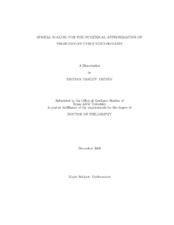| dc.contributor.advisor | Bramble, James H. | |
| dc.creator | Trenev, Dimitar Vasilev | |
| dc.date.accessioned | 2011-02-22T22:23:35Z | |
| dc.date.accessioned | 2011-02-22T23:44:30Z | |
| dc.date.available | 2011-02-22T22:23:35Z | |
| dc.date.available | 2011-02-22T23:44:30Z | |
| dc.date.created | 2009-12 | |
| dc.date.issued | 2011-02-22 | |
| dc.date.submitted | December 2009 | |
| dc.identifier.uri | https://hdl.handle.net/1969.1/ETD-TAMU-2009-12-7280 | |
| dc.description.abstract | In this dissertation we describe a coordinate scaling technique for the numerical
approximation of solutions to certain problems posed on unbounded domains in two
and three dimensions. This technique amounts to introducing variable coefficients into the problem, which results in defining a solution coinciding with the solution
to the original problem inside a bounded domain of interest and rapidly decaying
outside of it. The decay of the solution to the modified problem allows us to truncate
the problem to a bounded domain and subsequently solve the finite element
approximation problem on a finite domain.
The particular problems that we consider are exterior problems for the Laplace
equation and the time-harmonic acoustic and elastic wave scattering problems.
We introduce a real scaling change of variables for the Laplace equation and
experimentally compare its performance to the performance of the existing alternative
approaches for the numerical approximation of this problem.
Proceeding from the real scaling transformation, we introduce a version of the
perfectly matched layer (PML) absorbing boundary as a complex coordinate shift
and apply it to the exterior Helmholtz (acoustic scattering) equation. We outline the
analysis of the continuous PML problem, discuss the implementation of a numerical
method for its approximation and present computational results illustrating its
efficiency.
We then discuss in detail the analysis of the elastic wave PML problem and its numerical discretiazation. We show that the continuous problem is well-posed for
sufficiently large truncation domain, and the discrete problem is well-posed on the
truncated domain for a sufficiently small PML damping parameter. We discuss ways
of avoiding the latter restriction.
Finally, we consider a new non-spherical scaling for the Laplace and Helmholtz
equation. We present computational results with such scalings and conduct numerical
experiments coupling real scaling with PML as means to increase the efficiency of the
PML techniques, even if the damping parameters are small. | en |
| dc.format.mimetype | application/pdf | |
| dc.language.iso | en_US | |
| dc.subject | numerical approximation | en |
| dc.subject | unbounded domain | en |
| dc.subject | Helmholtz equation | en |
| dc.subject | PML | en |
| dc.subject | elastic wave scatering | en |
| dc.title | Spatial Scaling for the Numerical Approximation of Problems on Unbounded Domains | en |
| dc.type | Book | en |
| dc.type | Thesis | en |
| thesis.degree.department | Mathematics | en |
| thesis.degree.discipline | Mathematics | en |
| thesis.degree.grantor | Texas A&M University | en |
| thesis.degree.name | Doctor of Philosophy | en |
| thesis.degree.level | Doctoral | en |
| dc.contributor.committeeMember | Pasciak, Joseph E. | |
| dc.contributor.committeeMember | Lazarov, Raytcho D. | |
| dc.contributor.committeeMember | Sarin, Vivek | |
| dc.type.genre | Electronic Dissertation | en |
| dc.type.material | text | en |


